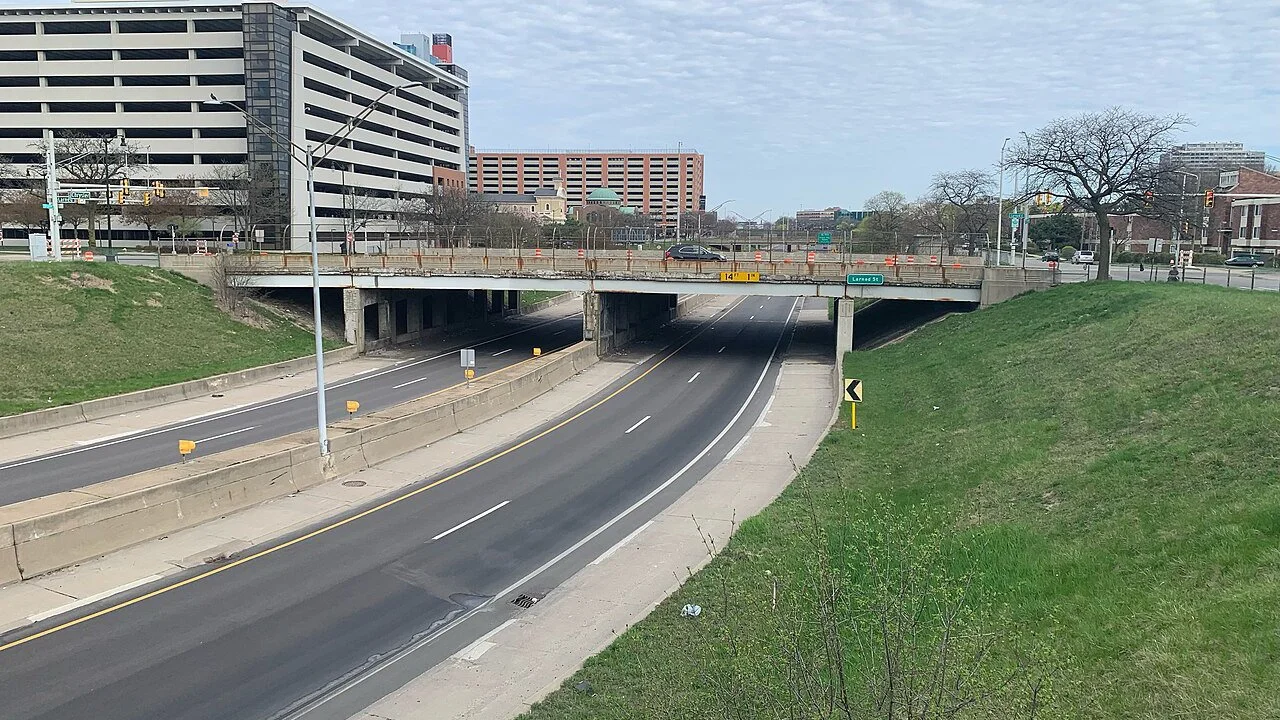MDOT’s Idea of Reconnecting Communities Is a $300 Million Stroad in Detroit
I-375 in Detroit. (Source: Wikimedia Commons/TenPoundHammer.)
"What could be more walkable than a six-lane boulevard?" joked David Gifford in response to the Michigan Department of Transportation’s (MDOT) plans for I-375, a sunken highway constructed in the 1950s and 1960s in Detroit.
"What could be more walkable than a six-lane boulevard?" "All the talk about "reconnecting neighborhoods" by surfacing 375 is mostly bosh. Black Bottom will not magically reappear (nor will the descendants of those displaced benefit) just because the expressway goes away." https://t.co/GHsRGUXyF4
— David Gifford (@DE_Gifford) August 15, 2023
Measuring only a mile, until recently I-375 was the shortest interstate in the country. Yet, its construction necessitated the displacement of 130,000 people and the destruction of Black Bottom and Paradise Valley, two once predominantly Black neighborhoods. To this day, locals feel that the interstate isolates eastern parts of Detroit from downtown.
MDOT, keenly aware of this history and seemingly interested in redressing past harms, is launching a transformation of the area. The project, Reconnecting Communities—not to be confused with the Federal grant of the same name—involves raising the sunken highway and converting it into a street-level boulevard. While city and community leaders have long favored eliminating I-375, converting it into a six-lane road is not the future they envisioned.
Critics of the project, like Gifford, argue MDOT’s language is a veneer for a project whose real aim is improving throughput. “This project has nothing to do with reconnecting downtown & Lafayette Park or undoing the destruction of Hastings Street & Black Bottom. It has everything to do with providing more connections to stadiums.”
This project has nothing to do with reconnecting downtown & Lafayette Park or undoing the destruction of Hastings Street & Black Bottom. It has everything to do with providing more connections to stadiums. pic.twitter.com/dUZ5G64zLb
— David Gifford (@DE_Gifford) August 15, 2023
The Devil Is in the Details
While MDOT’s project was not a recipient of the federal Reconnecting Communities and Neighborhoods Grant, the project did receive $105 million in federal funding of the requested $180 million through Infrastructure for Rebuilding America, or INFRA. It’s still a far cry from the project’s total price tag of $300 million, but the funding enabled the long-dormant project to finally get a start date.
Notably, the focus of the federal program, a product of the Bipartisan Infrastructure Law, is throughput for vehicles, particularly those that transport goods. "Today we are announcing transformative investments in our nation’s roads, bridges, ports, and rail to improve the way Americans get around and help lower the costs of shipping goods,” said U.S. Transportation Secretary Pete Buttigieg at the program’s unveiling in 2022.
Much like the Reconnecting Communities Grant, themes of equity, rehabilitation, and climate resiliency weave through INFRA’s press releases and applications. Yet, the supported projects arguably reaffirm that those themes are secondary to INFRA’s priorities.
In Flagstaff, Arizona, a project seemingly focused on pedestrian connectivity through the construction of underpasses in the city’s downtown actually services a future road widening. The city was awarded over $30 million through INFRA for “an underpass at Milton Road to allow for the future widening of the road from four lanes to six lanes and increased vertical clearances.” In Florida, $15 million is going towards parking for trucks along Interstate 4, though the application specifies additional “pedestrian infrastructure to access nearby commercial amenities.” In Washoe County, Nevada, $88 million in federal funds will ultimately add “two lanes along approximately three miles of US-395 with improved traffic control, interchange lighting upgrades, sound walls.” The project likewise involves “added sidewalks” and indecisiveness between “buffered bike lanes and/or shared-use paths.”
Returning to MDOT’s project, its priorities are given away by how many lanes are being retained. In fact, the Reconnecting Communities project manager, Jon Loree, expressed that capacity is a crucial feature of the project. “I believe in transit, and maybe someday people will be using that more and there’ll be opportunities to repurpose some of that space," Loree told the Detroit Free Press. "But we do need those lanes today.”
Learn 4 freeway-fighting tactics from the advocates who are pushing back against highway expansions in their communities.
For those in Michigan thrilled to see their state receive unprecedented federal funding to reshape an area that for the last 60 or so years has been a “non-place,” what MDOT is ultimately promising is disappointing. In fact, they see it as more of the same. As one local put it, it’s merely lifting a sunken expressway to street level.
Thank you for writing this. I thought a very similar thing when I first saw the plans. They are essentially just elevating the existing expressway. Creating arguably MORE of a boundary between downtown and near east side
— Jason Hackworth (@jasonhackworth9) August 15, 2023





Asia (pronounced “ah-sha”) Mieleszko serves as a Staff Writer for Strong Towns. A dilettante urbanist since adolescence, she's excited to convert a lifetime of ad-hoc volunteerism into a career. Her unconventional background includes directing a Ukrainian folk choir, pioneering synaesthetic performances, photographing festivals, designing websites, teaching, and ghostwriting. She can be found wherever Wi-Fi is reliable, typically along Amtrak's Northeast Corridor.